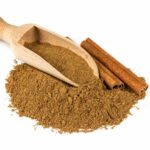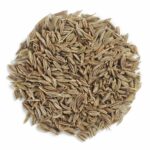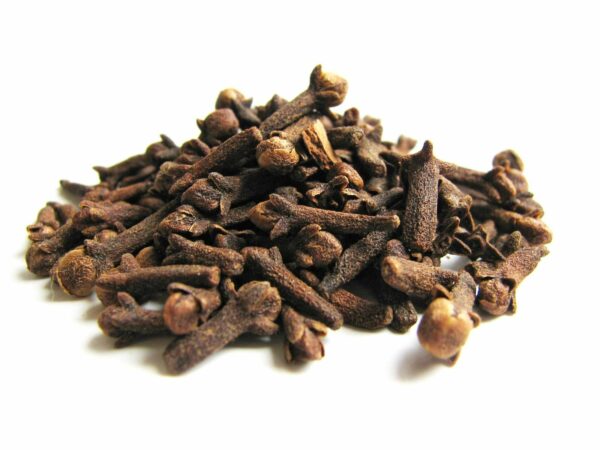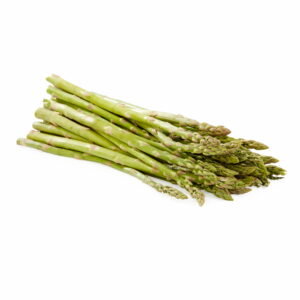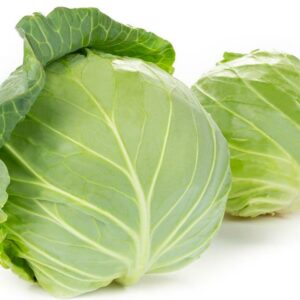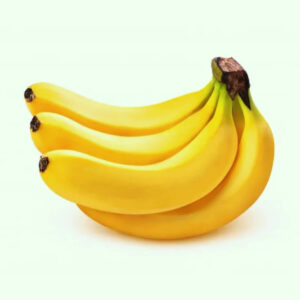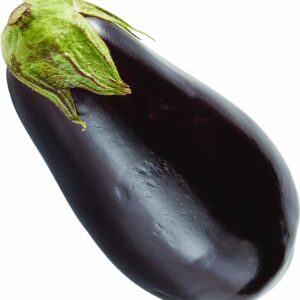Description
Like other spices, cloves are available throughout the year. They are renowned for providing their uniquely warm, sweet and aromatic taste to ginger bread and pumpkin pie, but they can also make a wonderful addition to split pea and bean soups, baked beans and chili.
Cloves are the unopened pink flower buds of the evergreen clove tree. The buds are picked by hand when they are pink and dried until they turn brown in color. Cloves are about 1/2-inch long and 1/4-inch in diameter and with their tapered stem, they resemble tiny nails. In fact, their English name is actually derived from the Latin word clavus, which means nail. Although cloves have a very hard exterior, their flesh features an oily compound that is essential to their nutritional and flavor profile.
2.00 tsp
(4.20 grams)
GI: very low
This chart graphically details the %DV that a serving of Cloves provides for each of the nutrients of which it is a good, very good, or excellent source according to our Food Rating System. Additional information about the amount of these nutrients provided by Cloves can be found in the Food Rating System Chart. A link that takes you to the In-Depth Nutritional Profile for Cloves, featuring information over 80 nutrients, can be found under the Food Rating System Chart.
- Health Benefits
- Description
- History
- How to Select and Store
- Tips for Preparing and Cooking
- How to Enjoy
- Nutritional Profile
- References
Health Benefits
Clove contains significant amounts of an active component called eugenol, which has made it the subject of numerous health studies, including studies on the prevention of toxicity from environmental pollutants like carbon tetrachloride, digestive tract cancers, and joint inflammation. In the United States, eugenol extracts from clove have often been used in dentistry in conjunction with root canal therapy, temporary fillings, and general gum pain, since eugenol and other components of clove (including beta-caryophyllene) combine to make clove a mild anaesthetic as well as an anti-bacterial agent. For these beneficial effects, you’ll also find clove oil in some over-the-counter sore throat sprays and mouth washes.
Anti-Inflammatory Activity
Eugenol, the primary component of clove’s volatile oils, functions as an anti-inflammatory substance. In animal studies, the addition of clove extract to diets already high in anti-inflammatory components (like cod liver oil, with its high omega-3 fatty acid content) brings significant added benefits, and in some studies, further reduces inflammatory symptoms by another 15-30%. Clove also contains a variety of flavonoids, including kaempferol and rhamnetin, which also contribute to clove’s anti-inflammatory (and antioxidant) properties.
A Nutrient-Dense Spice
Like its fellow spices, clove’s unique phytonutrient components are accompanied by an incredible variety of traditionally-recognized nutrients. Using our nutrient ranking system, we determined cloves to be an excellent source of manganese, a very good source of vitamin K and dietary fiber, and a good source of iron, magnesium, and calcium.
Description
Cloves are the unopened pink flower buds of the evergreen clove tree. The buds are picked by hand when they are pink and dried until they turn brown in color. Cloves are about 1/2-inch long and 1/4-inch in diameter and with their tapered stem, they resemble tiny nails. In fact, their English name is actually derived from the Latin word clavus, which means nail.
Although cloves have a very hard exterior, their flesh features an oily compound that is essential to their nutritional and flavor profile. Cloves have a warm, sweet and aromatic taste that evokes the sultry tropical climates where they are grown.
The Latin name for cloves is Eugenia caryophyllus.
History
Cloves are native to the Moluccas, formerly known as the Spice Islands of Indonesia. They have been consumed in Asia for more than 2,000 years. Owing to their sweet and fragrant taste, Chinese courtiers dating back to 200 BC would keep them in their mouths in order to freshen their breath when addressing the emperor so as to not offend him. Arab traders brought cloves to Europe around the 4th century, although they did not come into widespread use until the Middle Ages when they became prized for their pungent flavor that served to mask the taste of poorly preserved foods. While for a long time, they were cultivated almost exclusively in Indonesia, today the leading clove-producing region is Zanzibar in Eastern Africa. In addition to these two regions, cloves are also grown commercially in the West Indies, Sri Lanka, Madagascar, India, Pemba and Brazil.
How to Select and Store
Whenever possible, buy whole cloves instead of clove powder since the latter loses its flavor more quickly. When squeezed with a fingernail, good quality cloves will release some of their oil. Alternatively, you can place a clove in a cup of water. Those of good quality will float vertically while those that are stale will either sink or float horizontally.
Even through dried herbs and spices are widely available in supermarkets, explore the local spice stores or ethnic markets in your area. Oftentimes, these stores feature an expansive selection of dried herbs and spices that are of superior quality and freshness compared to those offered in regular markets. Just like with other dried spices, try to select organically grown cloves since this will give you more assurance that the herb has not been irradiated.
Cloves should be kept in a tightly sealed glass container in a cool, dark and dry place. Ground cloves will keep for about six months, while whole cloves will stay fresh for about one year stored this way. Alternatively, you can extend their shelf life by storing them in the refrigerator.
Tips for Preparing and Cooking
Tips for Cooking with Cloves
Since cloves have a very intense flavor, especially those that have been ground, care should be taken when deciding how much to use in a recipe so as to not overpower the flavors of the other ingredients.
The easiest way to grind whole cloves into a powder is to use a coffee grinder.
How to Enjoy
A Few Quick Serving Ideas
- Pierce an onion with whole cloves and add to soups, broths or poaching liquids.
- Adding ground cloves and curry powder to healthy sautéed onions, garlic and tofu will give this dish an Indian-inspired zest.
- Impart a warming note to apple cider by adding ground cloves and cinnamon.
- Spice up fruit compote by adding ground cloves.
- Add clove powder, walnuts and raisins to your favorite Thanksgiving stuffing recipe.
For some of our favorite recipes, click Recipes.
Nutritional Profile
Cloves are an excellent source of manganese. They are also a very good source of vitamin K and dietary fiber. They are also a good source of iron, magnesium and calcium.
Introduction to Food Rating System Chart
In order to better help you identify foods that feature a high concentration of nutrients for the calories they contain, we created a Food Rating System. This system allows us to highlight the foods that are especially rich in particular nutrients. The following chart shows the nutrients for which this food is either an excellent, very good, or good source (below the chart you will find a table that explains these qualifications). If a nutrient is not listed in the chart, it does not necessarily mean that the food doesn’t contain it. It simply means that the nutrient is not provided in a sufficient amount or concentration to meet our rating criteria. (To view this food’s in-depth nutritional profile that includes values for dozens of nutrients – not just the ones rated as excellent, very good, or good – please use the link below the chart.) To read this chart accurately, you’ll need to glance up in the top left corner where you will find the name of the food and the serving size we used to calculate the food’s nutrient composition. This serving size will tell you how much of the food you need to eat to obtain the amount of nutrients found in the chart. Now, returning to the chart itself, you can look next to the nutrient name in order to find the nutrient amount it offers, the percent Daily Value (DV%) that this amount represents, the nutrient density that we calculated for this food and nutrient, and the rating we established in our rating system. For most of our nutrient ratings, we adopted the government standards for food labeling that are found in the U.S. Food and Drug Administration’s “Reference Values for Nutrition Labeling.” Read more background information and details of our rating system.
|
Cloves, ground
2.00 tsp 4.20 grams Calories: 12
GI: very low |
||||
| Nutrient | Amount | DRI/DV (%) |
Nutrient Density |
World’s Healthiest Foods Rating |
|---|---|---|---|---|
| manganese | 2.53 mg | 110 | 172.0 | excellent |
| vitamin K | 5.96 mcg | 7 | 10.4 | very good |
| fiber | 1.42 g | 5 | 7.9 | very good |
| iron | 0.50 mg | 3 | 4.3 | good |
| calcium | 26.54 mg | 3 | 4.2 | good |
| magnesium | 10.88 mg | 3 | 4.1 | good |
| World’s Healthiest Foods Rating |
Rule |
|---|---|
| excellent | DRI/DV>=75% OR Density>=7.6 AND DRI/DV>=10% |
| very good | DRI/DV>=50% OR Density>=3.4 AND DRI/DV>=5% |
| good | DRI/DV>=25% OR Density>=1.5 AND DRI/DV>=2.5% |
In-Depth Nutritional Profile
In addition to the nutrients highlighted in our ratings chart, here is an in-depth nutritional profile for Cloves. This profile includes information on a full array of nutrients, including carbohydrates, sugar, soluble and insoluble fiber, sodium, vitamins, minerals, fatty acids, amino acids and more.
| Cloves, ground (Note: “–” indicates data unavailable) |
||
| 2.00 tsp (4.20 g) |
GI: very low | |
| BASIC MACRONUTRIENTS AND CALORIES | ||
|---|---|---|
| nutrient | amount | DRI/DV (%) |
| Protein | 0.25 g | 1 |
| Carbohydrates | 2.75 g | 1 |
| Fat – total | 0.55 g | 1 |
| Dietary Fiber | 1.42 g | 5 |
| Calories | 11.51 | 1 |
| MACRONUTRIENT AND CALORIE DETAIL | ||
| nutrient | amount | DRI/DV (%) |
| Carbohydrate: | ||
| Starch | — g | |
| Total Sugars | 0.10 g | |
| Monosaccharides | 0.10 g | |
| Fructose | 0.04 g | |
| Glucose | 0.05 g | |
| Galactose | 0.01 g | |
| Disaccharides | 0.00 g | |
| Lactose | 0.00 g | |
| Maltose | 0.00 g | |
| Sucrose | 0.00 g | |
| Soluble Fiber | — g | |
| Insoluble Fiber | — g | |
| Other Carbohydrates | 1.23 g | |
| Fat: | ||
| Monounsaturated Fat | 0.06 g | |
| Polyunsaturated Fat | 0.30 g | |
| Saturated Fat | 0.17 g | |
| Trans Fat | 0.01 g | |
| Calories from Fat | 4.91 | |
| Calories from Saturated Fat | 1.49 | |
| Calories from Trans Fat | 0.10 | |
| Cholesterol | 0.00 mg | |
| Water | 0.41 g | |
| MICRONUTRIENTS | ||
| nutrient | amount | DRI/DV (%) |
| Vitamins | ||
| Water-Soluble Vitamins | ||
| B-Complex Vitamins | ||
| Vitamin B1 | 0.01 mg | 1 |
| Vitamin B2 | 0.01 mg | 1 |
| Vitamin B3 | 0.07 mg | 0 |
| Vitamin B3 (Niacin Equivalents) | 0.09 mg | |
| Vitamin B6 | 0.02 mg | 1 |
| Vitamin B12 | 0.00 mcg | 0 |
| Biotin | — mcg | — |
| Choline | 1.57 mg | 0 |
| Folate | 1.05 mcg | 0 |
| Folate (DFE) | 1.05 mcg | |
| Folate (food) | 1.05 mcg | |
| Pantothenic Acid | 0.02 mg | 0 |
| Vitamin C | 0.01 mg | 0 |
| Fat-Soluble Vitamins | ||
| Vitamin A (Retinoids and Carotenoids) | ||
| Vitamin A International Units (IU) | 6.72 IU | |
| Vitamin A mcg Retinol Activity Equivalents (RAE) | 0.34 mcg (RAE) | 0 |
| Vitamin A mcg Retinol Equivalents (RE) | 0.67 mcg (RE) | |
| Retinol mcg Retinol Equivalents (RE) | 0.00 mcg (RE) | |
| Carotenoid mcg Retinol Equivalents (RE) | 0.67 mcg (RE) | |
| Alpha-Carotene | 0.00 mcg | |
| Beta-Carotene | 1.89 mcg | |
| Beta-Carotene Equivalents | 4.05 mcg | |
| Cryptoxanthin | 4.33 mcg | |
| Lutein and Zeaxanthin | 0.00 mcg | |
| Lycopene | 0.00 mcg | |
| Vitamin D | ||
| Vitamin D International Units (IU) | 0.00 IU | 0 |
| Vitamin D mcg | 0.00 mcg | |
| Vitamin E | ||
| Vitamin E mg Alpha-Tocopherol Equivalents (ATE) | 0.37 mg (ATE) | 2 |
| Vitamin E International Units (IU) | 0.55 IU | |
| Vitamin E mg | 0.37 mg | |
| Vitamin K | 5.96 mcg | 7 |
| Minerals | ||
| nutrient | amount | DRI/DV (%) |
| Boron | — mcg | |
| Calcium | 26.54 mg | 3 |
| Chloride | — mg | |
| Chromium | — mcg | — |
| Copper | 0.02 mg | 2 |
| Fluoride | — mg | — |
| Iodine | — mcg | — |
| Iron | 0.50 mg | 3 |
| Magnesium | 10.88 mg | 3 |
| Manganese | 2.53 mg | 110 |
| Molybdenum | — mcg | — |
| Phosphorus | 4.37 mg | 1 |
| Potassium | 42.84 mg | 1 |
| Selenium | 0.30 mcg | 1 |
| Sodium | 11.63 mg | 1 |
| Zinc | 0.10 mg | 1 |
| INDIVIDUAL FATTY ACIDS | ||
| nutrient | amount | DRI/DV (%) |
| Omega-3 Fatty Acids | 0.03 g | 1 |
| Omega-6 Fatty Acids | 0.12 g | |
| Monounsaturated Fats | ||
| 14:1 Myristoleic | 0.00 g | |
| 15:1 Pentadecenoic | 0.00 g | |
| 16:1 Palmitol | 0.00 g | |
| 17:1 Heptadecenoic | 0.00 g | |
| 18:1 Oleic | 0.04 g | |
| 20:1 Eicosenoic | 0.02 g | |
| 22:1 Erucic | 0.00 g | |
| 24:1 Nervonic | 0.00 g | |
| Polyunsaturated Fatty Acids | ||
| 18:2 Linoleic | 0.12 g | |
| 18:2 Conjugated Linoleic (CLA) | — g | |
| 18:3 Linolenic | 0.03 g | |
| 18:4 Stearidonic | — g | |
| 20:3 Eicosatrienoic | 0.00 g | |
| 20:4 Arachidonic | 0.00 g | |
| 20:5 Eicosapentaenoic (EPA) | 0.00 g | |
| 22:5 Docosapentaenoic (DPA) | 0.01 g | |
| 22:6 Docosahexaenoic (DHA) | — g | |
| Saturated Fatty Acids | ||
| 4:0 Butyric | — g | |
| 6:0 Caproic | 0.00 g | |
| 8:0 Caprylic | 0.00 g | |
| 10:0 Capric | 0.01 g | |
| 12:0 Lauric | 0.00 g | |
| 14:0 Myristic | 0.01 g | |
| 15:0 Pentadecanoic | 0.00 g | |
| 16:0 Palmitic | 0.08 g | |
| 17:0 Margaric | 0.00 g | |
| 18:0 Stearic | 0.03 g | |
| 20:0 Arachidic | 0.01 g | |
| 22:0 Behenate | 0.01 g | |
| 24:0 Lignoceric | 0.02 g | |
| INDIVIDUAL AMINO ACIDS | ||
| nutrient | amount | DRI/DV (%) |
| Alanine | 0.01 g | |
| Arginine | 0.01 g | |
| Aspartic Acid | 0.03 g | |
| Cysteine | 0.00 g | |
| Glutamic Acid | 0.02 g | |
| Glycine | 0.01 g | |
| Histidine | 0.01 g | |
| Isoleucine | 0.01 g | |
| Leucine | 0.02 g | |
| Lysine | 0.02 g | |
| Methionine | 0.00 g | |
| Phenylalanine | 0.01 g | |
| Proline | 0.02 g | |
| Serine | 0.01 g | |
| Threonine | 0.01 g | |
| Tryptophan | 0.00 g | |
| Tyrosine | 0.01 g | |
| Valine | 0.01 g | |
| OTHER COMPONENTS | ||
| nutrient | amount | DRI/DV (%) |
| Ash | 0.24 g | |
| Organic Acids (Total) | — g | |
| Acetic Acid | — g | |
| Citric Acid | — g | |
| Lactic Acid | — g | |
| Malic Acid | — g | |
| Taurine | — g | |
| Sugar Alcohols (Total) | — g | |
| Glycerol | — g | |
| Inositol | — g | |
| Mannitol | — g | |
| Sorbitol | — g | |
| Xylitol | — g | |
| Artificial Sweeteners (Total) | — mg | |
| Aspartame | — mg | |
| Saccharin | — mg | |
| Alcohol | 0.00 g | |
| Caffeine | 0.00 mg | |
Note:The nutrient profiles provided in this website are derived from The Food Processor, Version 10.12.0, ESHA Research, Salem, Oregon, USA. Among the 50,000+ food items in the master database and 163 nutritional components per item, specific nutrient values were frequently missing from any particular food item. We chose the designation “–” to represent those nutrients for which no value was included in this version of the database. |
||
References
- Amaechi BT, Higham SM, Edgar WM. Techniques for the production of dental eroded lesions in vitro. J Oral Rehabil 1999 Feb;26(2):97-102. 1999. PMID:12580.
- Ensminger AH, Esminger M. K. J. e. al. Food for Health: A Nutrition Encyclopedia. Clovis, California: Pegus Press; 1986. 1986. PMID:15210.
- Fortin, Francois, Editorial Director. The Visual Foods Encyclopedia. Macmillan, New York. 1996.
- Friedman M, Henika PR, Mandrell RE. Bactericidal activities of plant essential oils and some of their isolated constituents against Campylobacter jejuni, Escherichia coli, Listeria monocytogenes, and Salmonella enterica. J Food Prot 2002 Oct;65(10):1545-60. 2002.
- Ghelardini C, Galeotti N, Di Cesare Mannelli L, et al. Local anaesthetic activity of beta-caryophyllene. Farmaco 2001 May-2001 Jul 31;56(5-7):387-9. 2001. PMID:12570.
- Grieve M. A Modern Herbal. Dover Publications, New York. 1971.
- Krishnaswamy K, Raghuramulu N. Bioactive phytochemicals with emphasis on dietary practices. Indian J Med Res 1998 Nov;108:167-81. 1998. PMID:12540.
- Wood, Rebecca. The Whole Foods Encyclopedia. New York, NY: Prentice-Hall Press; 1988. 1988. PMID:15220.
